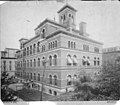| U.S. Post Office and Customs House | |
|---|---|
 | |
 Interactive map of U.S. Post Office and Customs House | |
| Former names | Atlanta City Hall |
| General information | |
| Type | Government offices |
| Location | 55 Marietta Street NW Atlanta, Georgia |
| Coordinates | 33°45′21″N84°23′28″W / 33.75574°N 84.39103°W |
| Completed | 1878 |
| Demolished | 1930s |
| Design and construction | |
| Architecture firm | Thomas G. Healey (1818-1897) [1] [2] |
The U.S Post Office and Customs House in Atlanta (also Atlanta's City Hall from 1910 to 1930) was a landmark building located on Marietta Street, occupying the block bounded by Marietta, Fairlie, Walton and Forsyth streets in the Fairlie-Poplar district of Downtown Atlanta. The building opened in 1878. In 1910 the City acquired the building and it was used as the Atlanta City Hall until 1930, after which it was razed. The lot was rebuilt in 1958 as the Fulton National Bank building, now the 55 Marietta Street building. [3]
Contents
- Building under construction, 1870s
- In use as a customs house and post office
- Postcard ca. 1910


